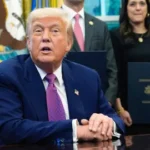The countries United States and China have agreed to temporarily reduce reciprocal tariffs in a deal that aims to de-escalate the ongoing trade war between the world’s two largest economies. This deal, which took many analysts by surprise, seeks to ease the fears of a global economic slump and restore stability to financial markets that have been rattled by the tariff dispute.
- US Tariff Reduction: The U.S. will lower the additional tariffs it imposed on Chinese imports in April 2025, reducing the rate from 145% to 30%.
- China’s Tariff Cut: China, in return, will reduce its tariffs on U.S. imports from 125% to 10%.
The new tariff reductions are set to last for 90 days, providing temporary relief to global trade, particularly industries and businesses affected by the escalating tariffs over the past year.
Global Reactions and Economic Impact
The announcement of the tariff cuts was met with a positive response in global financial markets. The U.S. dollar rose, and stock markets saw a boost, as the news alleviated concerns about a potential economic downturn, which had been fueled by the tariff conflict and the broader trade war. This deal helped ease the immediate fears of a global recession, particularly after U.S. President Donald Trump’s previous escalation of tariff measures.
- Treasury Secretary’s Statement: U.S. Treasury Secretary Scott Bessent, who was involved in the negotiations, praised the deal, stating, “Both countries represented their national interests very well.” Bessent emphasized that both nations share an interest in achieving balanced trade, and the deal marks a positive step toward that goal.
- Trade War Damage: The tariffs had stalled nearly $600 billion in two-way trade, disrupting global supply chains, increasing inflationary pressures, and leading to layoffs in various sectors. The agreement has been seen as a much-needed step to mitigate these adverse effects and restore some confidence in international trade.
Read More: Trump to Sign Executive Order Linking U.S. Drug Prices to Global Rates
Trade Discussions in Geneva
The breakthrough came after two days of intense negotiations in Geneva, Switzerland, marking the first in-person talks between senior U.S. and Chinese economic officials since Trump assumed office again. The discussions were framed as a “reset” in the trade relationship, with both sides working to narrow their differences and avoid a complete decoupling of their economies.
- No Sector-Specific Tariffs: U.S. Trade Representative Jamieson Greer clarified that the deal did not include sector-specific tariff reductions. The U.S. will continue to focus on rebalancing trade in strategic sectors such as medicine, semiconductors, and steel, where vulnerabilities in the supply chain have been identified.
- Conciliatory Tone: Both Bessent and Greer struck a conciliatory tone during the discussions, emphasizing that neither side wanted to continue with policies that could lead to an “embargo-like” situation. Instead, both countries expressed a desire to maintain open trade channels despite their differences.
Positive Impact on Global Markets
The tariff reduction deal had an immediate impact on stock prices, particularly in Europe. Shares of shipping giant Maersk surged by over 12%, reflecting optimism about the restoration of trade flows between the U.S. and China. Other companies in the luxury goods sector, including LVMH and Kering, also saw significant gains following the announcement.
- Market Optimism: The deal also led to a boost in Wall Street futures, sparking hope that the global economy might avoid a recession. Investors, relieved by the reduction in trade tensions, were buoyed by the prospect of more stable market conditions.
Also Read: Tariffs Remain in US-UK Trade Deal as Trump and Starmer Announce Historic Agreement
A Personal Touch to the Talks
The face-to-face nature of the talks in a more relaxed setting – at the Swiss U.N. Ambassador’s villa overlooking Lake Geneva – was credited with fostering better personal relationships between the U.S. and Chinese officials. Greer described the informal setting as instrumental in resolving many of the most challenging issues, highlighting the importance of personal rapport in diplomatic negotiations.
- Separate Track on Fentanyl: In addition to trade discussions, U.S. and Chinese officials also addressed concerns related to the trafficking of fentanyl, a deadly opioid. While these discussions were separate from the trade talks, they were considered “constructive” by both sides.
Conclusion
This temporary tariff cut deal between the U.S. and China represents a significant step toward de-escalating the trade war and stabilizing the global economy. While the agreement is only effective for 90 days, it has already had a positive impact on markets and has reduced fears of a global recession. With continued dialogue and cooperation, both countries may be able to pave the way for a more sustainable and balanced trade relationship in the future.
Follow 10X Times for more business news.






